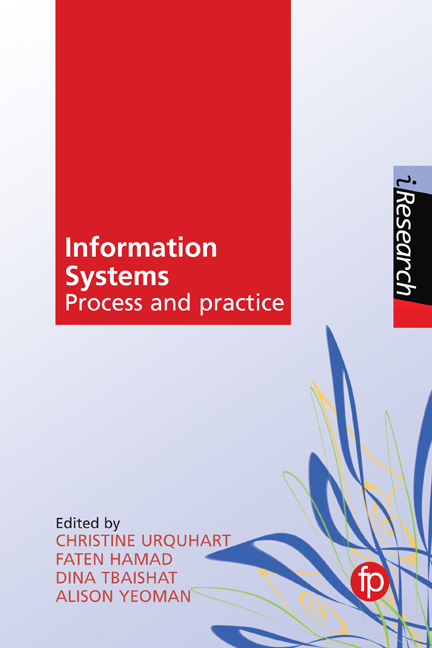Book contents
- Frontmatter
- Contents
- List of tables and figures
- Series editor's foreword
- About the authors
- 1 Introduction
- 2 Approaches to information architecture
- 3 Taxonomy testing for information architecture
- 4 The enterprise website and its information structures
- 5 Analysing activities, roles and processes
- 6 Libraries and the organisation of library processes – a history of operational research, and the use of process modelling
- 7 Using Riva process modelling to study book acquisition in academic libraries
- 8 Workflow analysis and process mapping in US academic libraries
- 9 A theoretical framework for designing and evaluating semi-structured document triage interfaces
- 10 Resource discovery case studies
- 11 Increasing social connection through a community-of-practice-inspired design
- 12 Methods for studying information provision, networking and communication in patient support groups
- 13 Health information systems: clinical data capture and document architecture
- 14 Producing systematic reviews and getting evidence to the clinician
- Index
8 - Workflow analysis and process mapping in US academic libraries
Published online by Cambridge University Press: 08 June 2018
- Frontmatter
- Contents
- List of tables and figures
- Series editor's foreword
- About the authors
- 1 Introduction
- 2 Approaches to information architecture
- 3 Taxonomy testing for information architecture
- 4 The enterprise website and its information structures
- 5 Analysing activities, roles and processes
- 6 Libraries and the organisation of library processes – a history of operational research, and the use of process modelling
- 7 Using Riva process modelling to study book acquisition in academic libraries
- 8 Workflow analysis and process mapping in US academic libraries
- 9 A theoretical framework for designing and evaluating semi-structured document triage interfaces
- 10 Resource discovery case studies
- 11 Increasing social connection through a community-of-practice-inspired design
- 12 Methods for studying information provision, networking and communication in patient support groups
- 13 Health information systems: clinical data capture and document architecture
- 14 Producing systematic reviews and getting evidence to the clinician
- Index
Summary
COMMENTARY: DINA TBAISHAT
This chapter investigates systems analysis, focusing on the workflow for processes and process mapping. Although there is a lot written on the need to change academic libraries, there is little published analytical research that investigates processes and how such investigations can lead to recommended improvements. When measuring library performance, the emphasis is more on outcomes and outputs (what is done) rather than internal processes (how things are done). However, it is important to understand both processes and roles in academic libraries, especially now when roles are changing and more intertwined. Processes are possibly more interdependent than they were, so it is necessary to focus on identification and analysis of discrete processes and responsible staff roles involved.
The chapter compares workflow analysis and process mapping in detail, following a well structured development of ideas. It starts by summarising two studies and then compares four aspects of them: aims and objectives, methods, analysis methods and findings. This comparative analysis study adds value to the field of systems analysis, specifically in librarianship, as managing change and embedding innovation is a key theme in academic libraries. It is important to identify gaps between current work (reality) and future intentions as stated in aims or strategies, as any mismatches indicate required improvements. This can be achieved by modelling processes that demonstrate the workflows, and discussing the findings with staff.
The framework adopted for comparison uses a ‘rich picture’ method to define stakeholders, their interrelationships and their concerns. This views a problem situation and provides a basis for analysis to reveal problems in some processes or communications. The framework included the job satisfaction fit areas identified by Mumford (1995), along with the type of participation (consultative, representative or consensual). The elements used in the framework helped express the problem situation and how communications were managed, according to the two studies under comparison.
This chapter relates to Chapter 5, which provides a detailed illustration of library processes in the form of a process architecture diagram, and Chapter 7, which presents a role activity diagram to model the book acquisitions process as an example of seeking process improvements.
- Type
- Chapter
- Information
- Information SystemsProcess and Practice, pp. 127 - 144Publisher: FacetPrint publication year: 2017



